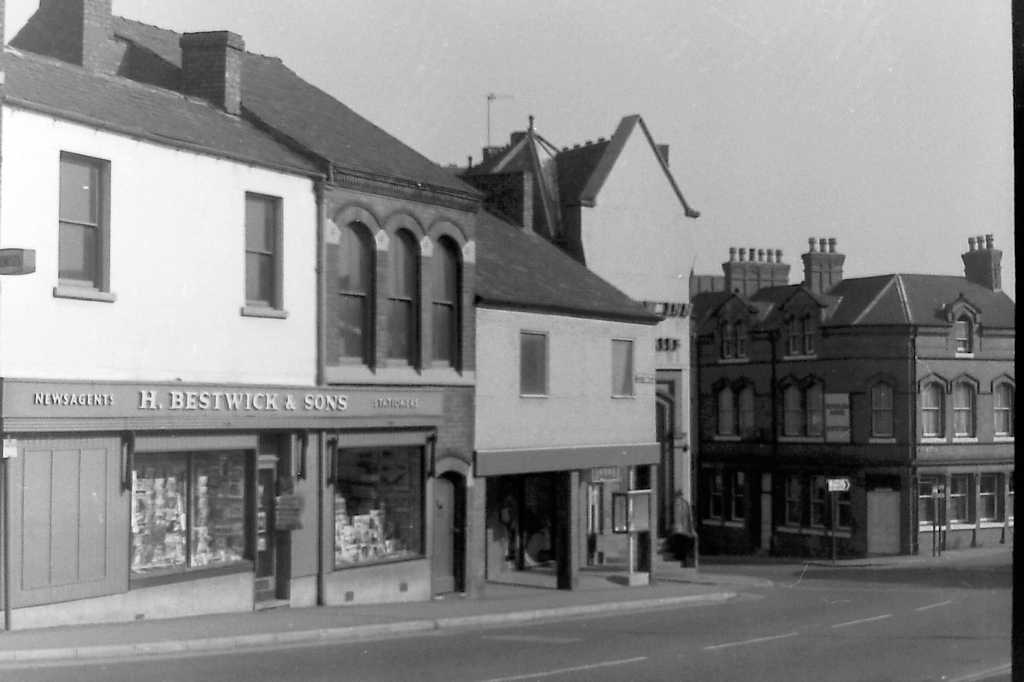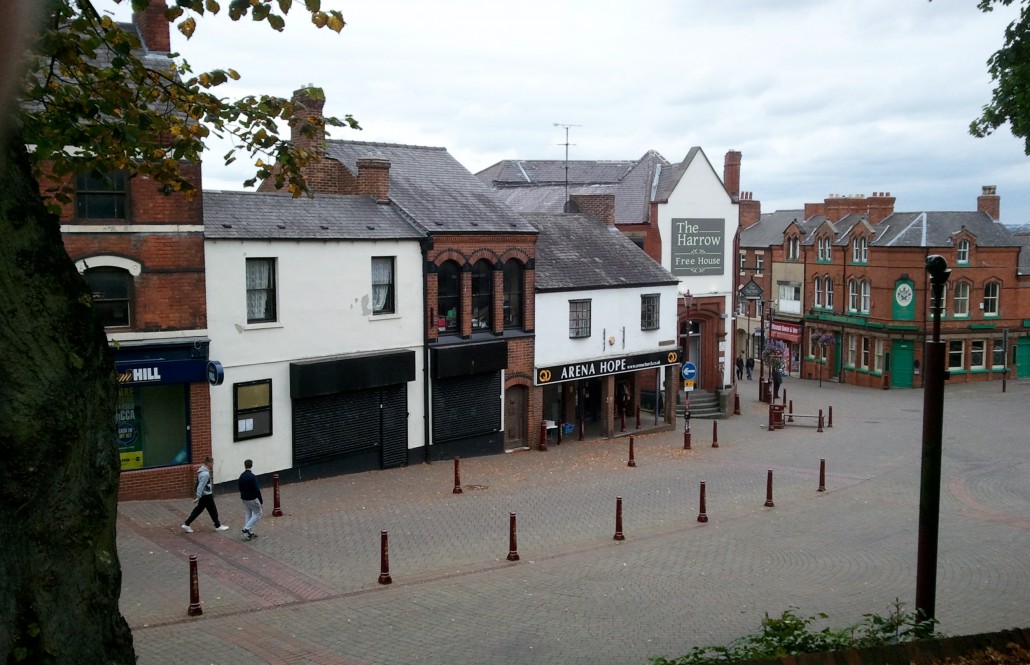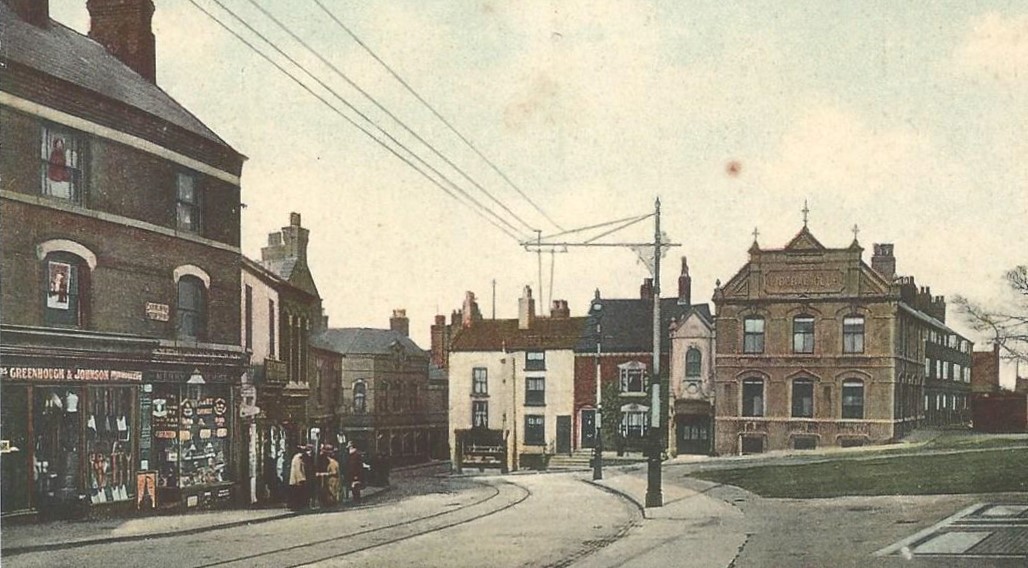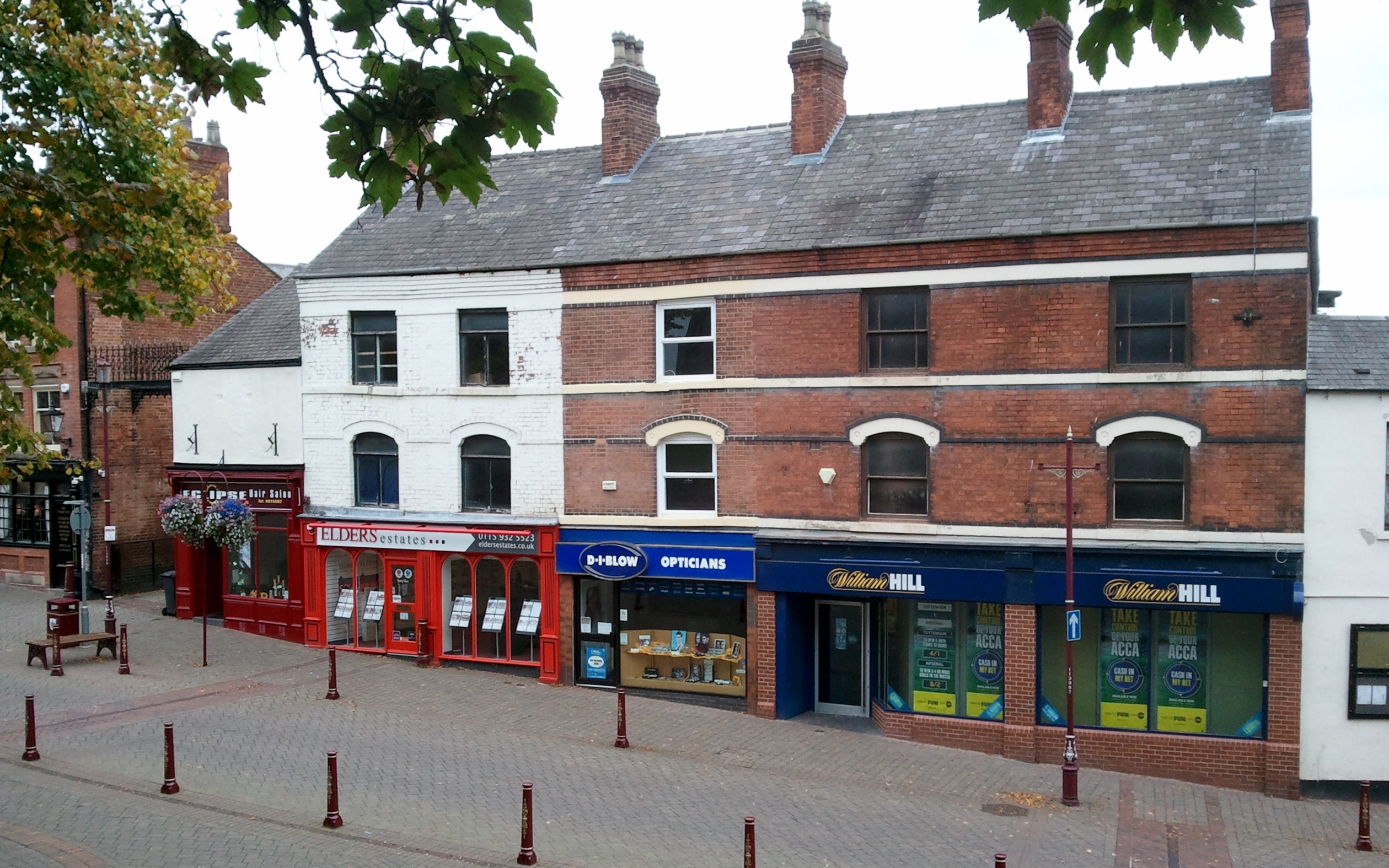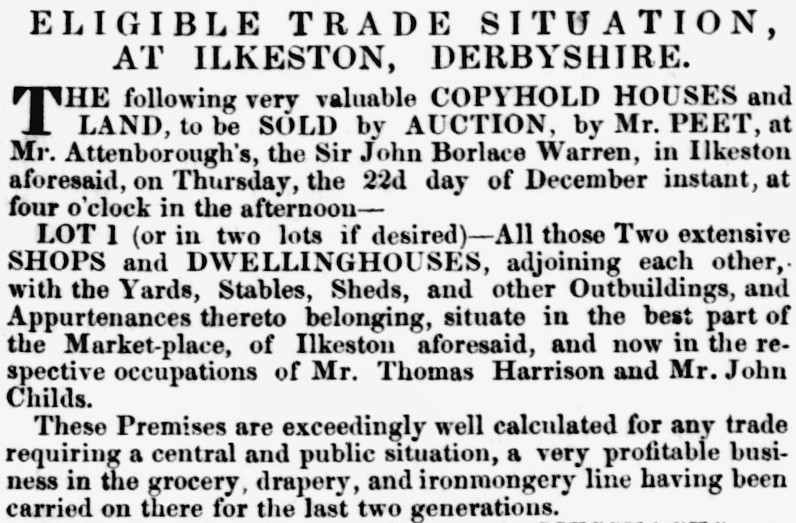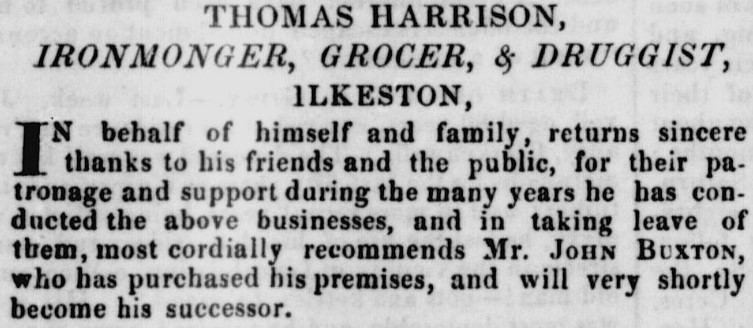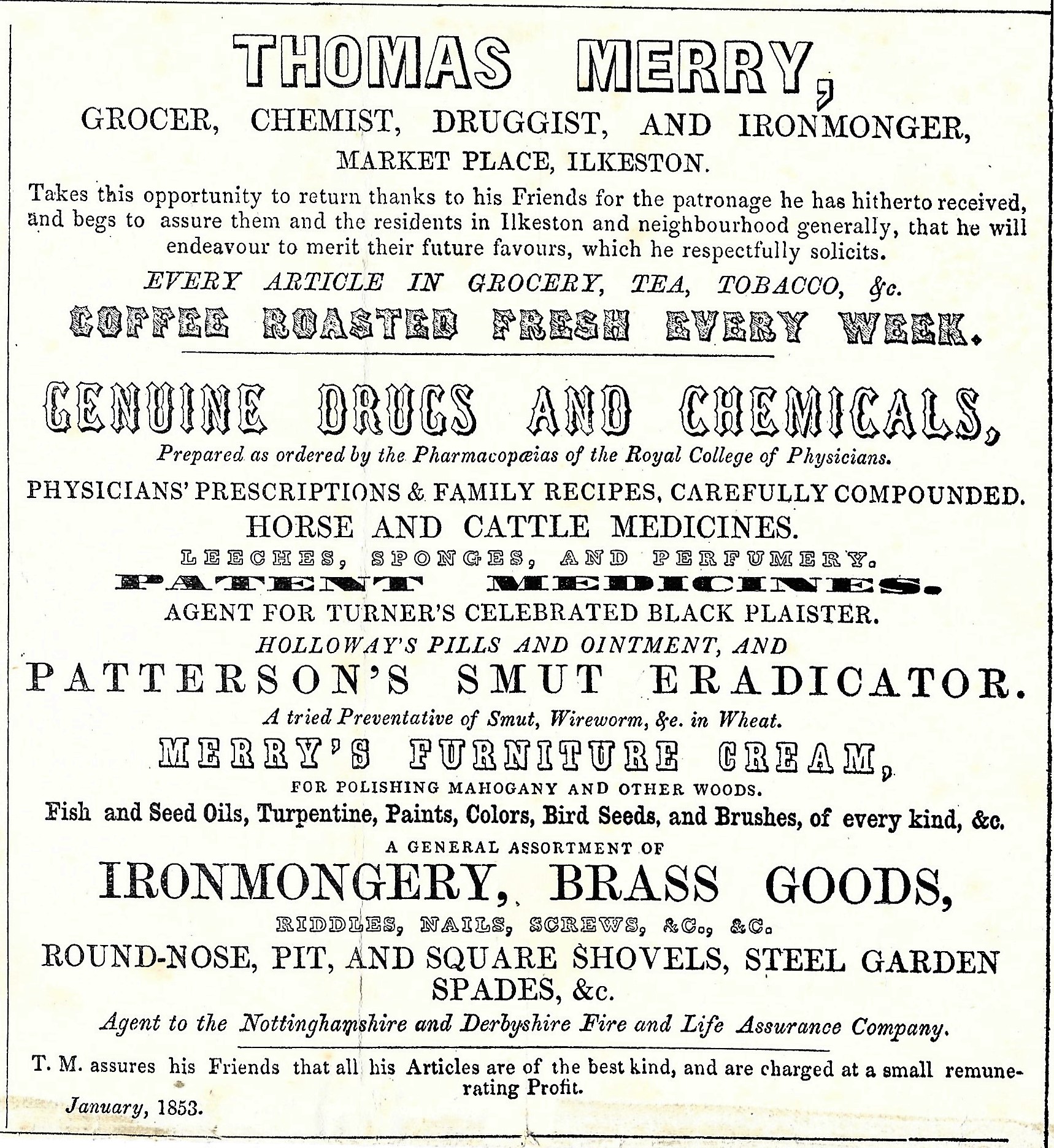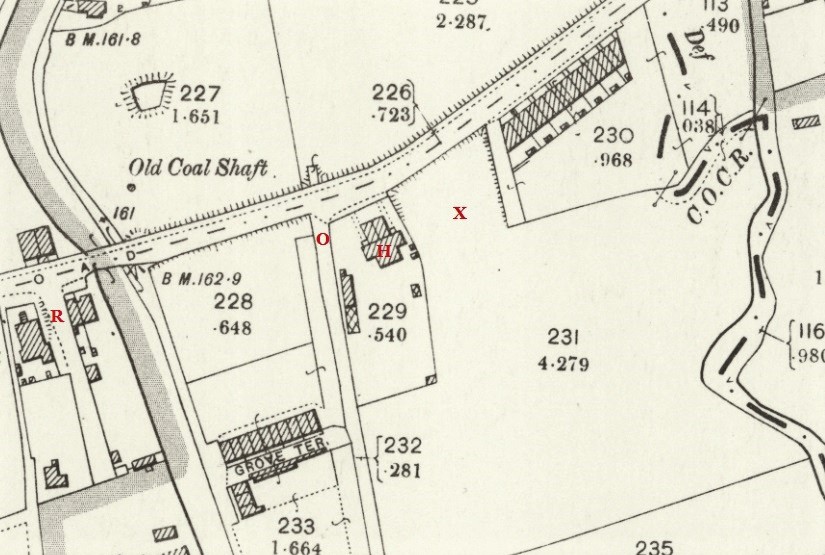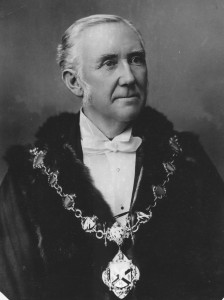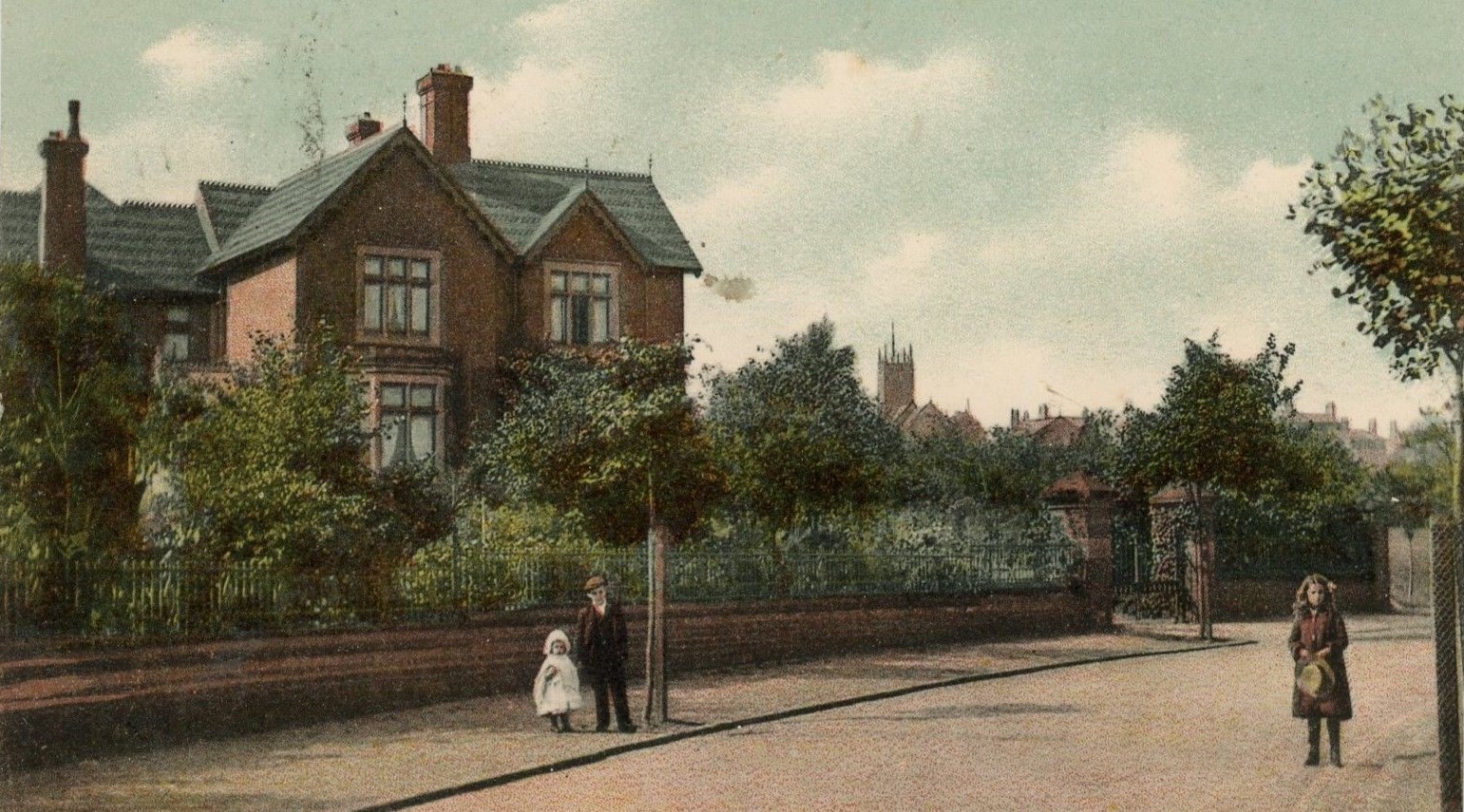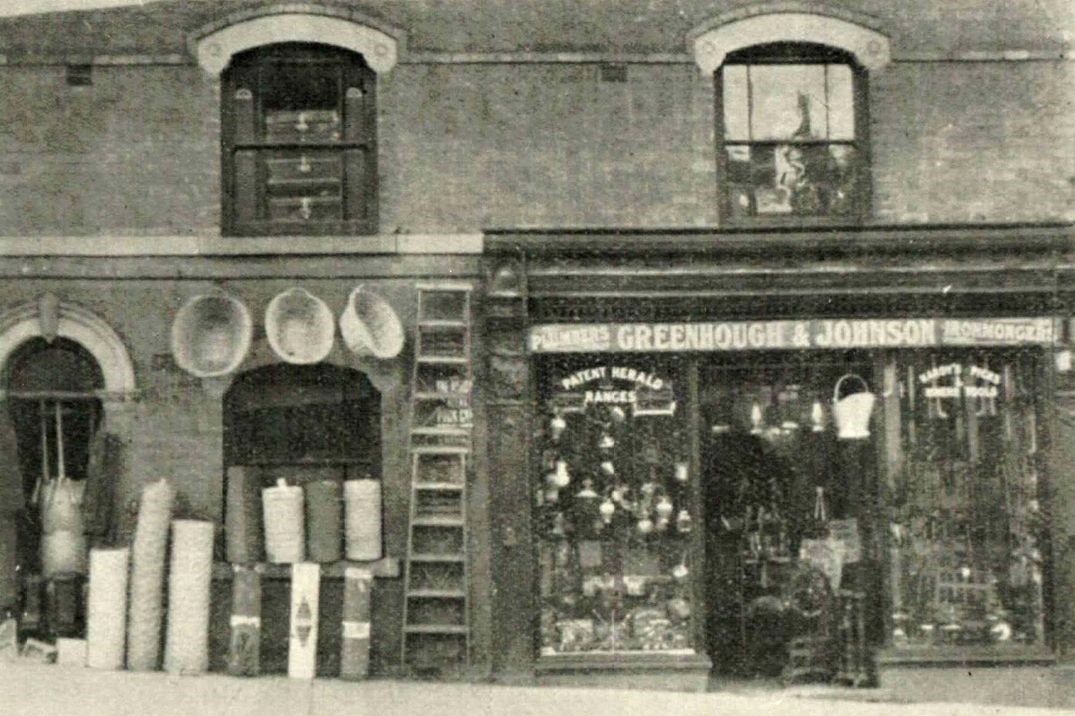Walking from the Old Harrow Inn and its next door neighbours …..
Remember this scene ?
The Borough Arms on the right, the Harrow Inn just peeking out, and newsagent Nelson Bestwick. (Jim Beardsley)
The Lower Market Place in 2015 , with the Harrow Inn (minus the ‘Harrow Corner’). And there, just appearing from around the tree on the left-hand side, is the Merry emporium.
———————————————————————————————————————————————-
Adeline writes that “the next two shops were taken by Mr. William Merry (?) and his two sons, William and Jim. This family came from Derby. They all attended the Independent Chapel in Pimlico”.
This was 11 Market Place in 1871 and still in 1881.
The photo above was taken at the end ot the Victorian era. On the extreme right is the alley known as Anchor Row, then, walking to the left, the imposing Liberal Club building and at the end of that row two shops with white facades — the right-hand one being occupied at one time by auctioneer and estate agent Edwin Sutton. In between was the so-called ‘Doctor’s House‘. Next is East Street and across the road is the Borough Arms. The Harrow Inn is largely obscured, and returning up the north side of Lower Market Place, where the group of pedestrians is located, another building with a white facade — the later Bestwick Newsagency, seen in the photos at the top.
And finally the two shop fronts which originally made up William Merry’s businesses at what were later numbers 16 (extreme left) and 18 Market Place
————————————————————————————————————————————————-
Thomas Merry
The Merry Building in 2020
It was Thomas Merry not William (as Adeline writes) who initially set up shop in the Market Place as grocer, druggist and ironmonger.
He had married Elizabeth Cholerton, daughter of Derby coach timber bender Thomas and Mary (nee Stansby), in May 1832 and the couple had four sons and a daughter — William, John, Thomas, Ann and James.
This shop was previously occupied by grocer and chemist Thomas Harrison who, by the end of 1842, had decided to leave the town, when both his premises and the adjoining one, tenanted by John Childs, were out up for sale. (advert below)
from the Nottingham Review (December 9th, 1842)
It should be noted that Lot 4 of the same auction comprised pasture land, a barn and cowhouse, and a large walled garden with fruit trees, totalling over four acres, then occupied by Jedediah Wigley. It was at this time, of course, that ‘Jerry’ decided upon a change of course in his business life.
And at the beginning of 1843 Thomas Harrison bade farewell to Ilkeston and its good folk …
As we can see, after his departure, Thomas Harrison’s shop and house were briefly occupied by John Buxton until the Merry family arrived. John left for Chicago, Illinois and died there on August 25th, 1847.
Thomas Merry had learned his trade from John Sandars, grocer, and hop and seed merchant of the Market Place in Derby (Alderman, J.P. and later Mayor of Derby). The Merry family moved from Derby about the autumn of 1846 to settle in the Market Place of Ilkeston.
Advertising its wares in the 1850’s, the Merry store offered groceries, tea, tobacco, freshly roasted coffee, genuine drugs and chemicals (prepared as ordered by the Pharmacopoeias of the Royal College of Physicians), doctors’ prescriptions and family recipes made up, horse and cattle medicines, Turner’s celebrated Black Plaster, Holloway’s pills and ointment, Patterson’s smut eradicator, Merry’s own furniture cream, fish and seed oils, turpentine, paints, colours, bird seed, brushes of all kinds, ironmongery, brass goods, riddles, nails, screws, a variety of shovels and spades….all items of top quality and reasonably priced.
From the Ilkeston Pioneer January 1853
Thomas Merry died in Derby in September 1871, aged 76.
——————————————————————————————————————————————
The Merry children
1 William
Born on July 22nd 1834 and educated at the Ockbrook Moravian School, William, also a druggist, married Elizabeth Hannah Sudbury, third daughter of Francis and Ann (nee Mather) on May 8th 1860 at Ilkeston Independent Chapel and went to live in South Street, in a property provided by his father-in-law.
At the beginning of 1864 his father transferred that part of the business which included ’the chemicals, drugs, oil, etc. department’ to William who then moved to live with his father in the Market Place. And a few years later he took over the ironmongery which had been managed by his younger brother James (see below).
About 1868 he became the Registrar of Marriages.
By 1891 William and his family had left the Market Place area to live at Holmdale, a large semi-detached house at the bottom of Station Road, near to the River Erewash and the Derbyshire/Nottinghamshire border. His conjoined neighbour was lace manager John Hancock. However, by June 1893 the family was moving once more and Holmdale was being offered for sale. It was described as two semi-detached residences with large gardens, conservatories, stabling, coachhouse, harness room, hayloft, summer house, and other appurtenances. John Hancock’s premises had a drawing room, dining room, library, four bedrooms, a large bathroom and w.c., a kitchen, pantry, cellar, china closet, and lobby. William’s residence had all these plus a billiard room used as a breakfast room, an extra kitchen and three extra bedrooms. Outside there was a large kitchen garden and a tennis court, all within three minutes walk of Ilkeston Junction railway station.
As well as the Holmdale residence (marked H on the map above) several plots of building land around the houses, mainly to the east, were also put up for sale. Within their description was mention of two proposed new streets in this area (marked X) named York Street and May Street — neither of which were ever built. There was mention also of ‘an occupation road‘ (marked O), to the west of the property; this was the Ropewalk. (To help with your bearings, R on the map is the later site of Rupert Street, not yet built)
In May 1896 these premises were, once more, up for auction, when the part previously occupied by John Hancock, had lately been occupied by Councillor Samuel Robinson. (Both York Street and May Street were again mentioned as ‘proposed new streets‘ and part of the auction).
At some time before the 1930s the western ‘semi’ of Holmdale was renamed as the Vines.
William Merry, Mayor of Ilkeston, 1892-1893. (courtesy of Ilkeston Reference Library)
William was elected Mayor of Ilkeston for 1892-1893.
In 1894 he disposed of the ‘ironmongery, plumbing, gas fitting and glazing departments‘ of his business. These were taken over by his two erstwhile assistants — Samuel Greenhough (1861-1944) and Benjamin George Johnson (1870-`1944).
William and Elizabeth Hannah retired to Parkhyrst, below, in Park Avenue.
William and Elizabeth Hannah both died there in December 1906 and December 1916 respectively. They were buried in the family grave at Ilkeston General Cemetery — about 40 metres along the central path, standing back and on the right, under a large stone Celtic cross. Buried in the same grave are their children, Annie Elizabeth (first child), Frank Cholerton (eldest son) and Annie (fifth daughter, despite what is inscribed on the gravestone).
In July of 1917 the contents of the home were auctioned off and then in September 1919 Parkhyrst was opened as a Maternity and Children’s Home, having been purchased by Ilkeston Town Council a few months earlier.
2. In 1861 second son John Cholerton married Mary Hannah Boden, eldest daughter of Derby baker Francis and Ann (nee Wheeler).
He then returned to Derby where he worked in the timber trade with his younger brother Thomas.
John Cartwright recalled that he died about 1891 in Edinburgh, by which time he was employed as a commercial traveller.
3. Son Thomas also worked in the Derby timber trade, occupying premises in Albion Street.
He married Caroline Mary Barton, daughter of Derby sculptor William and Betsy (nee Gregory) in February 1864.
4. Daughter Annie married at the Independent Chapel on September 13th, 1865, to William Christopher Moon, a travelling salesman in the chemist/druggist trade from the North East. The couple eventually settled at Gateshead.
5. Jim later on left the town (recalls Adeline)
Youngest son James was the ironmonger of the family but having married Eliza Jane Turner in May 1868 he left Ilkeston about 1870 with his wife and two children allowing his brother William to absorb the ironmongery.
James however continued his very successful trade at 86 St. Mary’s Road in Glossop and was there at the end of the century with his second wife Agnes (nee Hicks), eldest daughter of John Michael and Agnes Dolce (nee Whitehead). His first wife Eliza Jane had died in 1881.
—————————————————————————————————————————
Greenhough and Johnson, ironmongers of 16 Market Place
John Cartwright was an apprentice in the Merry store. We can read more about him as we explore Stanton Road.
However many other workers passed through the Merry ‘portals’ as shop assistants. One of these was Samuel Greenhough (1861-1944).
From 1877 until 1882 Samuel was schooled in the ironmongery trade at Belper with the guidance of John Loving. Then he secured a position as assistant at Merry’s Market Place establishment and moved to Ilkeston.
Two years later — on Christmas Day 1884 — he married Emma Jane Morley (or Moorley) at St. Michael’s Church in Stanton by Dale. The bride, a daughter of farmer Henry Tomlinson Morley and Penelope (nee Goodwin) had a rather convoluted family history which we will explore as we walk along South Street later. Samuel’s partner was another ‘Merry assistant’, Benjamin George Johnson.
In 1896 Benjamin George married Annie Merry, the daughter of William and Elizabeth Hannah. The Johnson couple had one daughter, Dorothy Mabel, born on July 17th, 1897 at 10 Gregory Street, before Annie died, aged 30, on January 8th 1899. At that time she was ‘taking the air’ at Llandudno. Her home was Orchard House in Nottingham Road at that time.
On July 23rd, 1902, at Victoria Street Congregational Church in Derby, Benjamin George remarried, to Carrie Gertrude Merry, younger sister of his late wife. Their first child was George Merry Johnson, born on July 8th, 1903 at 13 Drummond Road.
Faulty goods ??
John Reeve was a builder living in the Chapel Street area, and in 1895 had just erected a few houses in Wilmot Street. In one of them his first tenants were miner John Fisher and his family who moved in in June. Almost immediately Mary Ann, the miner’s wife, complained of a leaking bath. The builder went to inspect it and noticed a crack at the bottom, near the outlet, and running in a zig-zag up the side; he also noticed signs of a blow near the outlet. Mary Ann had previously said her young son had hit the bath with a hammer, but now was explaining that the crack had developed after the bath had been filled with cold water.
The bath had been supplied by Samuel Greenhough and he could vouch for its quality — of a quarter inch cast iron, it was made by Falkirk Iron Co. of Scotland (a very good firm !) and had been passed as perfect. It was an independent bath, not enclosed, and not in contact with the taps, which were attached to the wall. The bath and labour to fix it cost, in total, £4.
As far as John the builder was concerned it was the tenant’s liability and he sued John the miner for his £4.
Various ‘experts’ were called — builders, ironmongers, even the manager of the Whitehouse boiler works — some explaining that the crack was due to a violent blow while others were convinced it was caused by contraction. All the tenants swore that there was no-one in the bathroom when the bath cracked and it was empty at the time. Mary Ann even produced her three-year-old son into court to show how ridiculous it was to suggest he could have caused the damage.
The judge however couldn’t see how it was totally ‘fair wear and tear’; the tenant was liable to return the house to the owner in the same condition as he received it, less wear and tear. Thus John the miner was liable for the damage. He was charged £3 5s, payable at 5s a month.
———————————————————————————————
In 1896 William Merry’s daughter, Annie, married Benjamin George Johnson. Sadly Annie died just three years later — January 9th, 1899 — and after another three years, on July 23rd, 1902, Benjamin George married Annie’s younger sister, Carrie Gertrude Merry.
(Until the Deceased Wife’s Sister’s Marriage Act of 1907 it was forbidden for a man to marry the sister of his deceased wife. Any man who did so was not guilty of bigamy but of incest, and any children born to that incestuous marriage were illegitimate).
Greenhough and Johnson’s ironmongery (courtesy of Ilkeston Reference Library)
The Ironmongery at Number 16 Market Place, with William Merry’s shop at Number 18 provided the later site for Redvers Smith Ltd. Chemist.
————————————————————————————————————————————————–
After the Merry emporium we are at the shop of Mr. and Mrs. Childs.

